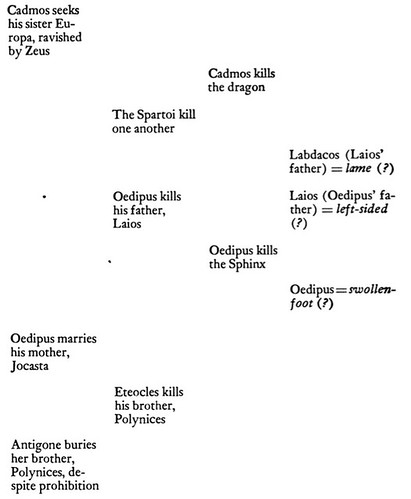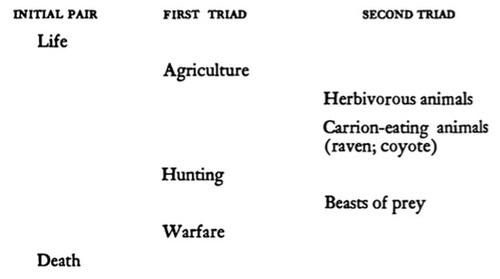Back on March 17, 2010 I made a short post to The Valve: “Style Matters”. I reposted it to New Savanna in June of 2012 and them bumped it to the top of the queue on September 6 of this year. That history suggests that the idea is important to me, yet until quite recently ¬– the last few weeks – it was just an isolated observation. Finally, however, I’ve incorporated it into the ongoing line of investigation.
It’s a line of thinking about the nature of humanistic investigation that I’ve been pursuing off and on since, well, forever, or at any rate since my undergraduate years at Johns Hopkins during the Sturm und Drang of Structuralism and deconstruction when I was led to believe, willingly I might add, that Western metaphysics was in shambles and it was up to us to create a new world. For me that meant cognitive science. Yes, I know, cognitive science and deconstruction don’t have much in common, then or now. But, strange as it may seem in retrospect, we didn’t know that BACK THEN. No one told me not to do it. My humanist teachers certainly didn’t say “no”, even if they didn’t really understand this cognitive science stuff, and some of them even encouraged me.
Little did I know that, when I’d opted for cognitive science, for all intellectual purposes I’d left the profession – by which I mean academic literary criticism. On the contrary, as things worked out, I was able to study with a world-class cognitive scientist while pursuing my Ph.D. in the English Department at SUNY Buffalo in the mid-1970s. Hays was in the Linguistics Department – had been its founding chairman – and the English Department, which was very experimental, was perfectly happy for me to study with Hays. And so I wrote a dissertation – Cognitive Science and Literary Theory – which was as much a technical exercise in cognitive science as it was a contribution to literary theory.
I figured that THAT would be my contribution to the discipline, my calling card. It got me my first and only academic job, and that was it. Not even a handful of publications, some in first-class journals, could get me a second academic job. By the mid-1980s my career was over. I’d left the profession.
But, as I said, in another sense I’d left the profession by the time I’d decided to pursue cognitive science in the course getting of my doctorate in English literature. While it was obvious to everyone at the time that my work was quite unusual for a literary scholar, it wasn’t at all obvious that it was out of bounds. Because it wasn’t.
Not back then. As I’ve said already, that boundary hadn’t been drawn. Oddly enough, though cognitive science now has a following in literary criticism, and has had one for at least two decades, the work I did back then is still out of bounds. Even though it wasn’t out of bounds when I did it.
Boundaries are strange things.
Structuralism and Its Rejection
And this brings me back to that post on style matters. In my sophomore year at Johns Hopkins I took Dick Macksey’s course, “The Idea of the Theatre” where I read Lévi-Strauss’s “The Structural Study of Myth” (in his collection, Structural Anthropology, Basic Books, 1963) which had a number of tables and simple diagrams in it, such as this one (p. 214):
A bit later this table showed up, illustrating Lévi-Strauss’s idea of mediation between binary extremes (p. 224):
It wasn’t clear to me just what was going on, but whatever it was, I liked it. So, when it came time to write a paper I included a table in it.
Ever since then I’ve been using tables and diagrams in my literary analysis. In some cases the diagrams and tables have been quite elaborate, in other cases, not so much. I all cases, though, the visual materials have been necessary. These are not mere visual aids to help understand something that’s adequately expressed in prose, not for Lévi-Strauss and certainly not for me. They are modes of primary thinking. Without them the work cannot get done.
That is to say, going back into my undergraduate years, the intellectual style I have used in thinking about literature has not been exclusively discursive, has not been prose-centric. I have come to realize, retrospectively, that the effect of these visual devices is to objectify some aspect of the texts under examination. And objectification seems to be anathema to some, perhaps many, humanists.
Literary critics, at least some of them, flirted with Lévi-Strauss, and structuralism more generally, for a decade or so in the 1960s and 1970s, but rejected it in favor of deconstruction and poststructuralism. I’ve always felt that, however the rejection was rationalized, the central motive force was a rejection of that objectification – something I’ve explored in at least two working papers [1]. It’s as if the critics had said to themselves, It’s all well and good to objectify the myths of South American aborigines, but we’re not going to do that to the central texts of the Western literary tradition. Not on your life! To be sure, some anthropologists – I’m thinking of Stanley Diamond in particular – objected to objectifying those myths; which is to say that it was clear that that’s what Lévi-Strauss was doing. And the literary critics would have none of it.
I have now come to suspect that this rejection of objectification is also a resistance to those diagrams and tables. They, after all, are the physical instruments of the descriptive objectification. It is a resistance to non-discursive thought, an insistence of remaining true to prose-centric methods.
The Tyranny of Prose
And that brings us back where we began, with style matters. Some people actively prefer to think in prose while others like thinking in mathematical or logical formulae, still others are fond of experimental design and statistical analysis, while still others like diagrams and tables. These methods are not, of course, necessarily exclusive, and some of us are quite happy with mixed intellectual modes.
My point, though, is that these modal preferences are (logically) prior subject-matter preferences. That is, to some extent, one chooses a domain of study because it is conducive to one’s preferred modes of thought. Prose-centric people will gravitate toward the humanities because most forms of humanistic investigation are discursive in kind. You do your central thinking in prose. In any given case a piece of work may start in scattered notes and observations and proceed through drafts of greater or lesser extent until one has finally pieced together a finished piece of work. In other more fortunate cases one might draft an all-but finished piece of work on a single try. Whatever the situation, the thinking has been done through the agency of writing ideas on paper and working with those written texts.
I have certainly done that kind of work. As an extreme case I remember a brief undergraduate paper that wrote itself though me, late at night. I was tired, the paper was due later that day (it was past midnight when the paper delivered itself) and at some point the paper just flowed through me and my typewriter and onto one page after another. Most papers, of course, have been more laborious. And many have been entirely in prose.
But I have also produced papers where the main work was in the diagrams. First I drew the diagrams, then I arranged them in order and wrote the prose needed to understand them. That is a very different mode of thinking; it is not what literary critics do.
Now, when literary critics rejected Lévi-Strauss, they didn’t say, “we don’t want to draw diagrams or create tables.” That’s just not how one carries out these debates. Derrida articulated a general line of rejection in his famous 1966 essay, “Structure, Sign, and Play in the Discourse of the Human Sciences” [2], and that, I’m told, is how things went. Derrida also adopted a strange notion of writing and argued against logocentric thought and Western metaphysics. Was this really just a defense of discursive prose as the primary instrument of humanistic discourse?
I don’t think so. But I do think that, in the larger scope of intellectual discourse, some of the stubbornness that emerges in humanistic resistance to science is, at the core, simply a preference for prose-centric modes of thinking. Science cannot be done only in prose. Something else is required. Physics requires equations, as does chemistry. Biology acquired equations (for genetics) in the early 20th century, but before that it required drawings as part of the equipment for describing life forms.
The idea that doing something beyond prose is a prerequisite for science, as obvious as it seems, is also a bit strange to me. I’m not quite sure what to make of it. I will note, however, that a week after I posted Style Matters to The Valve I posted “That Science Thing” and then reposted it to New Savanna under the title “I don’t give a crap about science”.
[…] I don’t worry about whether or not my work is sufficiently scientific. I worry about whether or not it is interesting, about rigor and coherence, about whether the prose is clear and, as appropriate, elegant. But is it scientific? Not an issue. Nor is it an issue in the work of others.Another thing I worry about is objectivity. Something I find deeply obscure.
I still find it a bit obscure. That doesn’t mean I don’t think it’s possible. I do. It’s what I’m after. But we can get objectivity unless we have objects. Objectification precedes objectivity. Objectification requires the we somehow move beyond prose.
* * * * *
[1] Beyond Lévi-Strauss on Myth: Objectification, Computation, and Cognition (2015), URL: https://www.academia.edu/10541585/Beyond_Lévi-Strauss_on_Myth_Objectification_Computation_and_Cognition
See the introduction to Prospects: The Limitation of Discursive Thinking and the Future of Literary Criticism (2015), URL: https://www.academia.edu/17168348/Prospects_The_Limits_of_Discursive_Thinking_and_the_Future_of_Literary_Criticism
I’ve also published that introduction as blog post, “Introduction: Beyond Discursive Thought”, URL: http://new-savanna.blogspot.com/2015/10/prospects-limits-of-discursive-thinking.html
[2] An English translation circulated informally soon after the conference ended and I read it them. It wasn’t published until later: Jacques Derrida, “Structure, Sign, and Play in the Discourse of the Human Sciences” in Eugenio Donato and Richard Macksey, eds., The Languages of Criticism and the Sciences of Man: The Structuralist Controversy (Baltimore: Johns Hopkins Press, 1970), pp. 247–265.


No comments:
Post a Comment